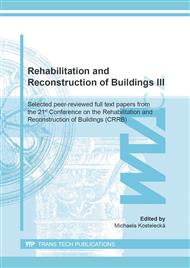[1]
P. ROVNANÍK, H. ŠIMONOVÁ, L. TOPOLÁŘ, P. BAYER, P. SCHMID, Z. KERŠNER: Carbon nanotube reinforced alkali-activated slag mortars, in: Construction and Building Materials, 2016, vol. 119, pp.223-229.
DOI: 10.1016/j.conbuildmat.2016.05.051
Google Scholar
[2]
R. OLAR: Nanomaterials and nanotechnologies for civil engineering, in: Buletinul Institului Politechnic Din Iasi, 2011, pp.110-117.
Google Scholar
[3]
M. VARGA, et al.: Great Variety of Man-Made Porous Diamond Structures: Pulsed Microwave Cold Plasma System with a Linear Antenna Arrangement. ACS Omega. 2019, 4(5), 8441-8450. ISSN 2470-1343. DOI 10.1021/acsomega.9b00323.
DOI: 10.1021/acsomega.9b00323
Google Scholar
[4]
M. ČERNOHORSKÝ, P. SEMERÁK, P. TICHÁ: Measuring of equivalent air layer thickness of nanofibre textiles, in: Key Engineering Materials, 2016, Vol. 714, pp.192-195.
DOI: 10.4028/www.scientific.net/kem.714.192
Google Scholar
[5]
A. M. EMEL'YANENKO, L. B. BOINOVICH: Analysis of Wetting as an Efficient Method for Studying the Characteristics of Coatings and Surfaces and the Processes that Occur on Them: A Review, in: Inorganic Materials, 2011, vol. 47, no. 15, pp.1667-1675.
DOI: 10.1134/s0020168511150064
Google Scholar
[6]
R. PERNICOVÁ, P. TICHÁ: Experimental method of measuring the efficiency of hydrophobic surface layer of concrete structures, in: EAN 2016 - 54th International Conference on Experimental Stress Analysis, 2016, pp.303-307.
Google Scholar
[7]
Y. YUAN, R.T. LEE: Contact Angle and Wetting Properties, in: Surface Science Techniques. Springer Series in Surface Sciences, 2013, vol. 51, pp.3-34.
DOI: 10.1007/978-3-642-34243-1_1
Google Scholar
[8]
K.L. MITTAL: Contact Angle, Wettability and Adhesion. vol. 6, Leiden: VSP, 2009. 397 p.
Google Scholar
[9]
O. JIRSÁK, T.A. DAO: Production, Properties and End-Uses of Nanofibres, in: Nanotechnology in Construction 3, Proceedings of the NICOM3. Springer, Berlin, Heidelberg, 2009, pp.95-99.
DOI: 10.1007/978-3-642-00980-8_11
Google Scholar
[10]
O. JIRSÁK, L. WADSWORTH: Nonwoven Textiles. Carolina Academic Pr, 1998. 133p.
Google Scholar
[11]
P. EXNAR: Metoda sol-gel. Liberec: Technická univerzita v Liberci, 2006. 61p.
Google Scholar
[12]
J. STUDNIČKOVÁ, P. EXNAR, J. CHALOUPEK: Silicon oxide nanofibers, in: 13th International Conference Strutex (Structure and Structural Mechanics of Textile Fabrics). Liberec, 2006, pp.173-178.
Google Scholar
[13]
Information on http://www.biolinscientific.com.
Google Scholar
[14]
Y. GAO, Y.B. TRUONG, Y. ZHU, L. KYRATZIS: Electrospun antibacterial nanofibers: production, activity, and in vivo applications, in: Journal of Applied Polymer Science, 2014, vol. 131, no. 18, p.9041–9053.
DOI: 10.1002/app.40797
Google Scholar
[15]
P. TICHÁ, A. SVESHNIKOV, P. DEMO, et al.: Determination of basic characteristics of protective layers based on polymeric nanofibers, in: M2D2015: Proceedings of the 6th International Conference on Mechanics and Materials in Design. Ponta Delgada, 2015, pp.825-830.
Google Scholar
[16]
P. TICHÁ, A. SVESHNIKOV, P. DEMO: Determination of surface properties of protective layers based on polymeric nanofibers, in: 8th International Conference on Materials – Research and Application (NANOCON). Brno, 2016, pp.345-350.
Google Scholar


